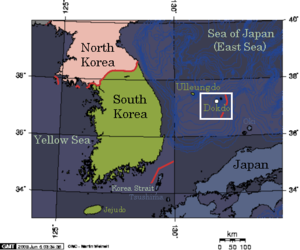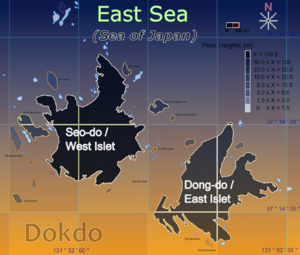Dokdo (Takeshima): Difference between revisions
imported>Chunbum Park |
imported>Chunbum Park |
||
| Line 76: | Line 76: | ||
Dokdo's ecology is influenced heavily by its climate and geography. Because of the strong, salty sea winds, the barren soil, and the lack of fresh water, vegetation grows poorly on the islets. There were originally only a few types of plants on the islets, but many more have been transplanted to Dokdo from the mainland since the S. Korean occupation. The islands can undergo severe drought if no rain or snow falls for a while because the thin layer of soil cannot retain much water and the amount of water produced by the moss covering the islands is little.<ref name="koreapdf"/> The However, because of its central location in the Sea of Japan, Dokdo is an important bird-breeding area and also a popular rest stop for the birds flying in the north-south direction. The black-tailed gulls that nest and breed on the islets between May and August<ref name="yahoo">[http://kr.news.yahoo.com/service/news/shellview.htm?linkid=4&articleid=2007061512000499001 독도 비상! 갈매기 1만마리 '똥폭탄' 공습], Kim Hye-mi, ''Yonhap News'', 2007-06-15, date accessed: 2008-05-27</ref> are the largest avian population in Dokdo.<ref name="empas">[http://news.empas.com/show.tsp/cp_kt/20060529n07424/?kw=kite%20%3Cb%3E%26%3C%2Fb%3E Dokdo Becomes Habitat for Rare Species], Kim Rahn, Korea Times, 2006-05-29, date accessed: 2008-05-27</ref> Dokdo's intermediary position in the clash between the warm and cold waters also allows for a diverse marine life including the dolphins, octopus, pollack, saury, abalone, turbo, and sea cucumber.<ref name="click05">[http://www.clickkorea.org/Dokdo/05.htm History and Culture of Dokdo Islands, Ecological Environment] hosted by the Korea Foundation</ref> However, the stellar sea lions and the fur seals that are native Dokdo have disappeared from the islands completely.<ref name="empas"/> | Dokdo's ecology is influenced heavily by its climate and geography. Because of the strong, salty sea winds, the barren soil, and the lack of fresh water, vegetation grows poorly on the islets. There were originally only a few types of plants on the islets, but many more have been transplanted to Dokdo from the mainland since the S. Korean occupation. The islands can undergo severe drought if no rain or snow falls for a while because the thin layer of soil cannot retain much water and the amount of water produced by the moss covering the islands is little.<ref name="koreapdf"/> The However, because of its central location in the Sea of Japan, Dokdo is an important bird-breeding area and also a popular rest stop for the birds flying in the north-south direction. The black-tailed gulls that nest and breed on the islets between May and August<ref name="yahoo">[http://kr.news.yahoo.com/service/news/shellview.htm?linkid=4&articleid=2007061512000499001 독도 비상! 갈매기 1만마리 '똥폭탄' 공습], Kim Hye-mi, ''Yonhap News'', 2007-06-15, date accessed: 2008-05-27</ref> are the largest avian population in Dokdo.<ref name="empas">[http://news.empas.com/show.tsp/cp_kt/20060529n07424/?kw=kite%20%3Cb%3E%26%3C%2Fb%3E Dokdo Becomes Habitat for Rare Species], Kim Rahn, Korea Times, 2006-05-29, date accessed: 2008-05-27</ref> Dokdo's intermediary position in the clash between the warm and cold waters also allows for a diverse marine life including the dolphins, octopus, pollack, saury, abalone, turbo, and sea cucumber.<ref name="click05">[http://www.clickkorea.org/Dokdo/05.htm History and Culture of Dokdo Islands, Ecological Environment] hosted by the Korea Foundation</ref> However, the stellar sea lions and the fur seals that are native Dokdo have disappeared from the islands completely.<ref name="empas"/> | ||
Currently, Dokdo is inhabited by 107 species of birds, 49 species of plants (of which 19 are alien species), 93 species of insects,<ref name="enmin">[http://eng.me.go.kr/docs/news/press_view.html?seq=334&page=3&mcode= Ministry of Environment Conducts Survey on Dok-do’s Ecosystem], Press Release, 2006-06-01, date accessed: 2008-05-27</ref> and as many as 100 species of fish.<ref name="koreapdf"/> There are some concerns about the possible | Currently, Dokdo is inhabited by 107 species of birds, 49 species of plants (of which 19 are alien species), 93 species of insects,<ref name="enmin">[http://eng.me.go.kr/docs/news/press_view.html?seq=334&page=3&mcode= Ministry of Environment Conducts Survey on Dok-do’s Ecosystem], Press Release, 2006-06-01, date accessed: 2008-05-27</ref> and as many as 100 species of fish.<ref name="koreapdf"/> There are some concerns about the possible harms on the islands' ecosystem that the 19 alien plant species could inflict as invasive species. | ||
==Notes== | ==Notes== | ||
{{reflist|2}} | {{reflist|2}} | ||
Revision as of 17:16, 27 May 2008
Dokdo is a small group of volcanic rocks located in the Sea of Japan. South Korea administers the islets as an area of the Ulleung County, Northern Gyeongsang Province. The 56-acre (226600 m2) formation consists of two main islands that house a lighthouse, a helicopter pad, and a small police force. Because the rocks shelter various species of fish, birds, plants, and insects, the South Korean government has designated the islets as a nature reserve and enforces measures to protect the islets from the visiting tourists. The sovereignty over Dokdo has been contested by Japan over historical and legal grounds and remains one of the more serious disputes between South Korea and its former colonial ruler. Since at least 1905, the islands were called in Japanese Takeshima (竹島), meaning the "bamboo island". The Korean name has many different transliterations in English, including "Tok-do", "Dok-to", and "Tok Islets" (독도), all of which equate to "rocky island". The islets have two English titles: Liancourt Rocks and Hornet Rocks. "Liancourt" has its origin in the name of the French whaling ship that first encountered and charted the islets in 1849.
Geography
Template:2isletsdata Dokdo lies in the Sea of Japan as a part of an underwater volcano that erupted repeatedly[2] from 4.6 to 2.5 million years ago.[3] The underwater Dokdo volcano stands 2 km high on its base with a diameter of 20 ~ 25 km and rises to a guyot[4] summit that is 10 km wide.[5] The islets on top of this summit consist mostly of trachyte and trachyandesite differentiated from the parental alkali basalt magma of the underwater volcano.[6] Samples of these rocks reveal that Dokdo is the oldest existing island in Korea (Awaji Island is the oldest in Japan)[7]; the second oldest island in Korea is Ulleungdo,[8] which formed 2 million years after Dokdo from the same hot spot, with similar igneous composition to Dokdo.[2] Due to sedimentation, the 2 islands (Seo-do and Dong-do in Korean, Otoko-jima and Onna-jima in Japanese; both literally meaning western island and eastern island, respectively)[9][10] that make up most of the island cluster above water split 2 million years ago,[2] and are now positioned 151 meters apart from each other.[11] The western islet is steeper and larger than the eastern islet, and it is the tallest islet in the cluster.[12] 87 smaller rocks scatter around the two main islands within a radius of a few kilometers,[13] and more than 30 of such geographical features have been named by the South Korean government ministries.[14]
Climate & Ecology
Dokdo has a moderate maritime climate created by the warm[5] and cold ocean currents that collide nearby the islands.[1] The average year-round temperature is 12°C, and the coldest and the hottest extremes occur in January (1°C) and August (23°C) respectively. The average yearly rainfall is 1,240 mm, and in the winter the islands experience a heavy snowfall. In a year, there are only about 50 clear days, more than 160 days are cloudy or foggy, and rain or snow falls on the remaining 150 days.[15]
Dokdo's ecology is influenced heavily by its climate and geography. Because of the strong, salty sea winds, the barren soil, and the lack of fresh water, vegetation grows poorly on the islets. There were originally only a few types of plants on the islets, but many more have been transplanted to Dokdo from the mainland since the S. Korean occupation. The islands can undergo severe drought if no rain or snow falls for a while because the thin layer of soil cannot retain much water and the amount of water produced by the moss covering the islands is little.[1] The However, because of its central location in the Sea of Japan, Dokdo is an important bird-breeding area and also a popular rest stop for the birds flying in the north-south direction. The black-tailed gulls that nest and breed on the islets between May and August[16] are the largest avian population in Dokdo.[17] Dokdo's intermediary position in the clash between the warm and cold waters also allows for a diverse marine life including the dolphins, octopus, pollack, saury, abalone, turbo, and sea cucumber.[18] However, the stellar sea lions and the fur seals that are native Dokdo have disappeared from the islands completely.[17]
Currently, Dokdo is inhabited by 107 species of birds, 49 species of plants (of which 19 are alien species), 93 species of insects,[19] and as many as 100 species of fish.[1] There are some concerns about the possible harms on the islands' ecosystem that the 19 alien plant species could inflict as invasive species.
Notes
- ↑ 1.0 1.1 1.2 1.3 Part I: Profile of Dokdo
- ↑ 2.0 2.1 2.2 Geographical and Geological Features of Dokdo. Truth of Dokdo. Retrieved on 2007-09-03.
- ↑ Volcanic Landforms, The National Atlas of Korea, retreived 2008-05-10
- ↑ A study on the geophysical characteristics of the summit of the Dokdo volcano in the East Sea (Japan Sea)
- ↑ 5.0 5.1 History and Culture of Dokdo Islands, Geographical understanding, hosted by the Korea Foundation
- ↑ Gravity modeling for understanding internal structure of seamounts, Kang Mohee et al, date accessed: 2008-05-24
- ↑ 2003 iEARN Conference News. '. Retrieved on 2007-09-03.
- ↑ The Territorial Sovereignty over Dokdo Islets(Liancourt Rocks) and the Cairo Declaration in 1943. Seoul National University. Retrieved on 2007-09-03.
- ↑ Special Report: Tokdo-Takeshima Dispute (doc). Pride of Korea - Dokdo (2001-07-06). Retrieved on 2007-09-02.
- ↑ The Issue of Takeshima, The Ministry of Foreign Affairs of Japan, date accessed: 2008-05-24
- ↑ Korea.net (1999–2006). Dokdo: A Profile. Retrieved 9 January, 2006.
- ↑ Dokdocorea.com, date accessed: 2008-05-23
- ↑ Dokdo of Korea. National Geographic Information Institute. Retrieved on 2007-09-02.
- ↑ Ten reefs around Dokdo to receive names, Korea.net
- ↑ http://www.dokdo.go.kr/
- ↑ 독도 비상! 갈매기 1만마리 '똥폭탄' 공습, Kim Hye-mi, Yonhap News, 2007-06-15, date accessed: 2008-05-27
- ↑ 17.0 17.1 Dokdo Becomes Habitat for Rare Species, Kim Rahn, Korea Times, 2006-05-29, date accessed: 2008-05-27
- ↑ History and Culture of Dokdo Islands, Ecological Environment hosted by the Korea Foundation
- ↑ Ministry of Environment Conducts Survey on Dok-do’s Ecosystem, Press Release, 2006-06-01, date accessed: 2008-05-27

